We are saddened as our lives have been forever impacted by the Covid-19 pandemic. Everyone has now experienced the impact of Coivd-19 whether directly by the disease, by economic hardship, or as one of our brave medical workers and essential workers on the frontlines worked to exhaustion. And some of you are impacted in all manners. Our thoughts are with you!
Businesses and social gathering places are reopening even though we are still at the very beginning of the Coronavirus pandemic. Guidelines for “reopening” are scattered, conflicting and confused. Primary guidelines to not gather in groups of more than 10, stay 6 feet apart, wear facemasks (to protect others, not you), not touch your face, and wash regularly are important, but there is much more to reopening safely.
Our March and April Covid-19 articles discuss airborne disease transmission characteristics and reducing disease transmission through “social distancing”. After two months of social distancing in the US, business and social interactions are increasing. Business owners have been left in a state of confusion, and are sometimes instituting practices that enhance rather than inhibit disease transmission. For example, one restauranteur in Ohio installed transparent plastic sheets around each table, reducing ventilation air flow and increasing fomite (contagion coated objects) surface area.
Our practical and effective guidelines for inhibiting the spread of airborne contagions will also refresh your brain and improve sleep. And, with an efficient smart ventilation system automatically managing healthy air, you’ll be freed from the continual weight of stress and worry.
Build Equinox Covid-19 Recommendations
For homes, business, and public gathering places:
For businesses and public gathering places:
Effective ventilation should be on the frontline of defense to protect our homes, schools, and businesses from Covid-19. Current ventilation practices do not provide sufficient protection against disease transmission. We use a simple example to demonstrate the inadequacy current ventilation standards, and how CERV2 smart ventilation automatically meets a person’s fresh air needs.
Background
Protection from contagions has been a primary objective of our CERV ventilation technology from the beginning. Read our February 2017 article discussing how smart ventilation reduces the impact of influenza and colds. Why is the state of ventilation so focused on “saving” energy in lieu of improving our health? Our health is much more valuable than energy, especially in this day and age of affordable renewable energy. Current “odor” based ventilation standards are making us sick, stupid and tired. It is time to think beyond energy and to put building occupant health, comfort and security at the forefront of building design priorities, with energy as an important constraint. The good news is that you can have your cake and eat it, too, as demonstrated by our plus-zero Equinox House project, and our 4500 square foot, net zero Build Equinox business headquarters.
Keeping indoor carbon dioxide concentration levels below 800ppm, especially during the pandemic, is crucial for reducing the airborne spread of Covid-19. Our March newsletter provided a detailed discussion of the relationship between indoor carbon dioxide concentration level and concentration of a contagion. The amount of an airborne contagion, such as the SARS-CoV-2 virus, is directly related to a contagious individual “shedding” the virus through breathing, speaking, coughing and sneezing. Increased fresh air ventilation, filtration of recirculation air, and additional sanitizing using UVGI (ultraviolet germicidal irradiation) or other disinfectants significantly reduce contagion concentration, and therefore, the probability that one becomes infected. References included at the end of this article lists journal articles with current Covid-19 research, and other relevant information on respiratory viruses, their transmission, survival, and control.
An infectious “dose” of a contagion is defined as a “quanta”, with one quanta resulting in a 63% probability (probability = 1-exp(-q), where q=quanta) of infection. There are many possible contagion transmission paths as a virus leaves its host to find another susceptible person. With Covid-19, touching the eyes, nose, or mouth after touching a contaminated surface (“fomite”) may also deliver doses of infection, although the CDC has reduced their emphasis on this infection pathway while further increasing their emphasis of direct infection spread through the air.
Figure 1 shows how infection probability is related to indoor carbon dioxide concentration and time spent indoors with an infected person. The example assumes 4 occupants with 1 infectious occupant. Minimizing time is important as well as fresh air dilution of contagion and carbon dioxide. Note that for 4 people, 25% of carbon dioxide in the room (above ambient conditions) is exhaled from the infected person. If there are 2 occupants with one infectious and the other susceptible, the quanta of infectious doses would be twice as great at the same carbon dioxide concentration. Therefore, the exposure time curves would be reduced in half (ie, a half hour exposure results in the same infection probability as a 1 hour exposure at a given carbon dioxide concentration).
Ventilation should be a weapon against disease spread, however, poorly designed, poorly installed, and poorly operated systems can be enhancers rather than inhibitors of disease spread. We compare effective ventilation versus ineffective ventilation with another example. Our example is a 1000ft2 residence with 8ft ceilings, such as a multi-family apartment or manufactured (mobile) home. The home has 2 bedrooms with four occupants. We choose this residence because it represents the area in which current ventilation standards are most deficient. Our example is also representative of housing in dense, urban environments where Covid-19’s spread has been devastating.
Current residential ventilation standards are deficient in two important areas: insufficient fresh air ventilation per person and lack of filtered recirculation air. Our Smart Ventilation and Smart Air Distribution reports cover these important aspects of ventilation design, and how smart ventilation allows one to simultaneously be more energy efficient and healthy. Current ASHRAE 62.2-2019 standards specify 52.5cfm for the example residence, or 13cfm per person. EPA indoor airPLUS allows the outdated and horribly insufficient ASHRAE62.2-2010 standard that specifies 32.5cfm, or 8cfm per person. Passive House ventilation standards, both PHI and PHIUS, allow 0.3ACH, or 40cfm (10cfm per person).
Build Equinox has recommended 40cfm per person for several years. Why? Three reasons:
1) Research shows that sick days are reduced by 40% by doubling current rule-of-thumb 20cfm per person to 40cfm person, equivalent to the effectiveness of the flu vaccine
2) A study from Harvard’s TH Chan School of Public Health estimates increasing ventilation from 20cfm to 40cfm per person improves cognition performance with an increased human productivity value of $6500 per person relative to only $50 per person utility cost increase
3) A study by the Danish Technical University, a leading center for healthy indoor environment research, demonstrates that our recommended fresh air level improves sleep and next day activity performance
The real question is why anyone would choose to live in a home or visit buildings with inadequate fresh air that promotes sickness, degrades brain function, and disturbs sleep?? Current ventilation standards are based on odor, not health, and lack of odor is not an indicator of healthy air.
Build Equinox considers filtered recirculation of indoor air as an essential feature of ventilation systems. Many high performance home standards, such as Passive House International, fail to understand the importance of air recirculation. “Sufficient” fresh air as described by PHI is not healthy air. We need exceptional indoor environments and recirculation is an important part. Recirculation is important for 3 reasons:
As discussed in our article on particulates, “The Perfect Dust Storm”, most particulates in today’s homes are generated indoors from cooking and human activities. A home without recirculation will have much higher particulate levels than one with filtered recirculation. A contagion’s airborne concentration, such as the SARS-CoV-2 virus, are significantly reduced with filtered recirculation, too.
Universal Guidelines 1, 2, and 3:
Our first 3 guidelines for home and public spaces (schools, businesses, restaurants and other indoor public gathering spaces) reduce the probability of infection by reducing contagion concentration in the air through higher fresh air ventilation rates (40cfm per person), filtered recirculation of indoor air, and UVGI sanitizing of recirculation air.
Professor Stephens and colleagues at the Illinois Institute of Technology published an article [12] examining the spread of bacteria and virus throughout a residential scale test facility. A respiration and “cough” machine introduced non-lethal bacteria and virus particles into the test space. A central HVAC system recirculated air throughout the residence, with air samplers and “settle” plates placed in different regions of the residence.
An interesting and important difference between bacteria loaded droplet tests and viral particle loaded tests is the dramatic difference in droplet deposition characteristics. Bacteria, with a characteristic size similar to respiratory droplets, alters droplet sizes and results in droplets being heavily deposited near the respiration machine. Viral loaded droplets have much smaller droplet sizes and did not settle near (0.5m) the droplet generation machine. The region of highest viral mass was found to be 3 meters (~10feet) away from the respiration source! Significant viral mass was also measured 5m away from the respiration/coughing source while a negligible amount of viral mass was found near the respiration machine. The authors reported that MERV8 filtration of recirculation air did not noticeably reduce viral loadings in the residence in comparison to unfiltered recirculation air. MERV11 and MERV16 filters did effectively capture viral mass by 85 to 95% within the residence. We therefore estimate that a MERV13 filter can similarly remove 90% of viral particulates.
Figure 2 compares the probability of Covid-19 disease transmission assuming one infected person shedding the virus at 100quanta per hour. Three susceptible people are in the building with the infectious person. Spending 8 hours or more with an infected person under EPA indoor airPLUS (ASHRAE62.2-2010), Passive House (0.3ACH), and current ASHRAE62.2-2019 ventilation standards is very likely (>95% probability) to result in the other 3 people becoming infected. As soon as a second person is infected and shedding virus, the probability of infecting others jumps higher.
Increasing fresh air ventilation to our recommended 40cfm per person (160cfm total fresh air) lowers infection probability to 75%. Operating the ventilation system with an air recirculation rate of 90cfm through a MERV13 filter further decreases infection probability during 8 hours of co-occupation to 60%. Note that the 40% reduction in disease transmission probability from today’s standard practice to our suggested fresh air recommendation is in line with the sick day reduction determine by Milton and colleagues [6] in their study of over 3000 employees in several building environments of varying ventilation and recirculation rates in which they demonstrated a 40% sick day reduction.
Adding UVGI to recirculation air can further reduce contagions. ASHRAE’s recent UVGI webinar by Professor William Bahnfleth of Penn State, an international expert in UVGI, stated that 0.02WUVGI per cfm of air flow is sufficient for 85% “single pass kill” efficiency. For our example house with 160cfm of fresh air ventilation, 3.2WUVGI of radiant power is needed, which is approximately 13W of electrical power, assuming a 25% conversion efficiency to UV radiation. Professor Bahnfleth, who is also a former ASHRAE President, is a leader promoting the importance of exceptional rather than sufficient indoor environments (see Figure 3, and watch our 2016 webinar on smart ventilation).
Figure 2 shows an estimated UVGI reduction of infection probability from 60% for 40cfm per person with 90cfm of MERV13 filtered recirculation air to 50%. Operating a 13W UV lamp continuously requires 114kWh of electric energy, or about $14 per year of solar supplied energy assuming 12 cents per kWh. Reducing the probability of someone in your household catching a cold, the flu or Covid-19 by spending approximately $1 per month seems like something to consider even if it downgrades your home’s energy certification rating.
Business and Public Gathering Guidelines 4, 5, and 6:
Additional protections are recommended for work, schools, restaurants and other public gathering places in which you have increased uncertainty of interacting with infectious persons. The insidious nature of Covid-19 asymptomatically affecting people makes it difficult to detect and contain.
In addition to using UVGI for sanitizing ventilation and recirculation air, UVGI lamp fixtures are available that mount on ceilings and walls. The lamps operate at a sufficiently high power to sanitize surfaces in a room, such as table, desks, shelves, etc. These systems are primarily used in medical facilities, however, perhaps incorporation into gathering places such as restaurants and businesses with large public turnover (eg, Motor Vehicle offices) could benefit from their usage. The lights are operated during unoccupied periods, typically at night. Robotic UVGI units are now available that monitor UV dosage delivered to different surfaces. A study from one medical facility reported a 10-fold drop in contagions on surfaces that had been sterilized with a disinfectant [18].
Wearing a cloth mask in public places (and at home when you suspect you may be infected) significantly reduces droplets released from respiration, talking, coughing and sneezing. A 50% reduction of released contagion is very significant, as shown in Figure 4. The example building described previously (4 occupants with one infectious occupant) is modeled in this figure. Standard building ventilation practice cases continue to have 90% level probability of infection transmission with 8 hours of occupation while increased fresh air with filtered and UV irradiated air reducing 8 hour infection probability to below 40%.
Our final recommendation for protecting you against infection is to stay much farther away than 6 feet from unmasked, unknown persons. Think of how far you can smell smoke from a cigar to gauge a safe distance, and if possible detect air flow direction (outside, too), and move upwind. Perhaps we need to request “masked seating” in restaurants, similar to non-smoking sections of the recent past.
Practical Implementation of Guidelines:
The connection between carbon dioxide concentration and contagion concentration makes verification of fresh air flow simple. We recommend that you acquire a good quality carbon dioxide sensor with 30ppm accuracy, which costs $200 to $300. Less expensive units are available, however accuracy and stability tend to be less reliable. Figure 5 shows two handheld CO2 instruments. The red one costs $260 and the white one costs $500 (we’ve had it for 10 years with lots of use). Maybe share the cost with some friends or co-workers, and use it to map out building air quality in a variety of places that you regularly visit. If carbon dioxide is above 800ppm, re-think whether you want to stay in that indoor space. Remember that today’s building ventilation standards are based on 1000 to 1200ppm, so don’t be surprised at finding concentration levels above 800ppm. At the same time, you should find many spaces with 800ppm or less because ventilation designers often make conservative estimates as to occupancy levels, resulting in higher ventilation levels.
And then, there are those places with poor air quality, such as commercial airlines. Yes, the CEOs of several airlines have been on television assuring us that their fleet operates with 20 air changes per hour and recirculates air through a HEPA filter. Figure 6 shows a different reality with CO2 concentration measurements on a flight I took from Philly to Burlington Vermont. Obviously, fresh air per person was very low, and I caught the flu. Trust, but verify!
CERV2 Smart Ventilation:
Equinox House, our Zero-Plus demonstration home in Urbana Illinois (and Ty and Debs’ house) normally operates with CERV CO2 and total VOC setpoints of 850ppm, however, at the beginning of March, we switched IAQ setpoints to 650ppm. Figure 7 shows indoor air quality at excellent levels (both CO2 and total VOCs), along with stable, comfortable indoor temperature and humidity. Although climatic loads on average are low during the “swing seasons”, maintaining stable comfort conditions can be difficult. If you would like to look at Equinox House data over the past 4 years, check out live Equinox House control settings on the front page of our website under “Take Control”. Learn how to design an economical, high performance, and healthy house by following our seven steps to net zero design webinar.
And, stay tuned for an upcoming announcement of CERV-UV! A new option for CERV2 owners.
References
1) KP Talaro, A Talaro, Foundations in Microbiology, 3rd Ed, McGraw Hill, 1999
2) M Moriyama, WJ Hugentobler, A Iwasaki, “Seasonality of Respiratory Viral Infections”, Annu.Rev.Virol.2020.7:2.1–2.19, Mar 2020
3) James Holland Jones, “Notes on R0, class notes”, Dept of Anthropology, Stanford University, May 2007
4) “What you should know about COVID-19 to protect yourself and others”, CDC Factsheet, cdc.gov/coronavirus
5) “Modes of transmission of virus causing COVID-19: implications for IPC precaution recommendations”, World Health Organization, scientific brief, Mar 29, 2020
6) DK Milton, PM Glencross, MD Walters, “Risk of Sick Leave Associated with Outdoor Air Supply, Humidification, and Complaints”, Indoor Air, 2000, 10: pp 212-221
7) TA Myatt, J Staudenmayer, K Adams, M Walters, SN Rudnick, DK Milton, “A Study of Indoor Carbon Dioxide Levels and Sick Leave Among Office Workers”, Environmental Health: A Global Access Science Source 2002, 1
8) AC Lowen, S Mubareka, J Steel, P Palese, “Influenza Virus Transmission Is Dependent on Relative Humidity and Temperature”,PLoS Pathogens, October 2007, Volume 3,Issue 10
9) LC Marr, JW Tang, J Van Mullekom, SS Lakdawala, “Mechanistic Insights into the Effect of Humidity on Airborne Influenza Virus Survival, Transmission and Incidence”, JR Society Interface 16: 20180298, 2019
10) KA Kormuth, K Lin, AJ Prussin, EP Vejerano, AJ Tiwari, SS Cox, MM Myerburg, SS Lakdawala, LC Marr, “Influenza Virus Infectivity Is Retained in Aerosols and Droplets Independent of Relative Humidity”, J Infectious Diseases, 2018:218 September
11) L Bourouiba, “Turbulent Gas Clouds and Respiratory Pathogen Emissions Potential Implications for Reducing Transmission of COVID-19”, JAMA Published online March 26,2020, pE1
12) SA Kunkel, P Azimi, H Zhao, BC Stark, B Stephens, “Quantifying the size- resolved dynamics of indoor bioaerosol transport and control”, Indoor Air. 2017;27:977–987
13) N van Doremalen, T Bushmaker, DH Morris, MG Holbrook, A Gamble, BN Williamson, A Tamin, JL Harcourt, NJ Thornburg, SI Gerber, JO Lloyd-Smith, E de Wit, VJ Munster, “Aerosol and surface stability of HCoV-19 (SARS-CoV-2) compared to SARS-CoV-1”, medRxiv preprint (not peer-reviewed) https://doi.org/10.1101/2020.03.09.20033217doi
14) Lu J, Gu J, Li K, Xu C, Su W, Lai Z, et al. “COVID-19 outbreak associated with air conditioning in restaurant, Guangzhou, China, 2020”, Emerg Infect Dis. 2020 Jul, https://doi.org/10.3201/eid2607.200764
15) JL Santarpia, DN Rivera, V Herrera, MJ Morwitzer, H Creager, GW Santarpia, KK Crown, DM Brett-Major, E Schnaubelt, MJ Broadhurst, JV Lawler, St. Patrick Reid, JJ Lowe, “Transmission Potential of SARS-CoV-2 in Viral Shedding Observed at the University of Nebraska Medical Center”, medRxiv preprint, https://doi.org/10.1101/2020.03.23.20039446doi
16) LA Anchordoqui, EM Chudnovsky, “A physicist view of the airborne infection”, arXiv:2003.13689v1 [physics.pop-ph] 30 Mar 2020
17) SN Rudnick, DK Milton, “Risk of indoor airborne infection transmission estimated from carbon dioxide concentration”, Indoor Air, 2003; 13: 237–245
18) Titus Wong, Tracey Woznow, Mike Petrie, Elena Murzello, Allison Muniak, Amin Kadora, Elizabeth Bryce, “Postdischarge decontamination of MRSA, VRE, and Clostridium difficile isolation rooms using 2 commercially available automated ultraviolet-C–emitting devices”, American Journal of Infection Control, Vol 44 (2016), pp 416-420






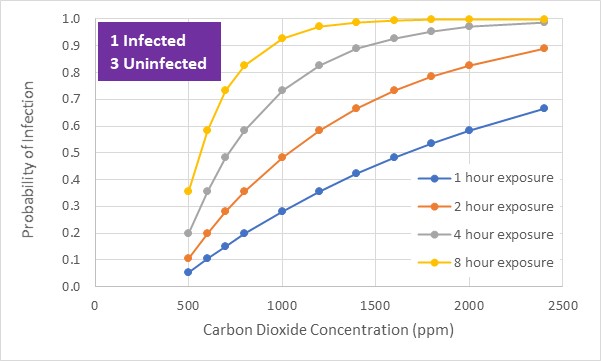 Figure 1: Example home (1000sqft, 4 occupants, 1 infected shedding 100quanta per hour) relationship between infection probability and indoor carbon dioxide concentration.
Figure 1: Example home (1000sqft, 4 occupants, 1 infected shedding 100quanta per hour) relationship between infection probability and indoor carbon dioxide concentration.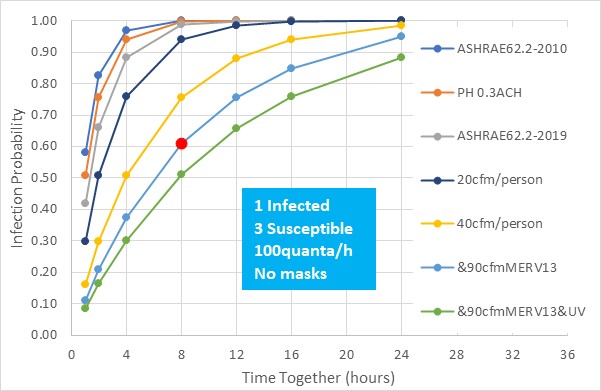 Figure 2: Improved ventilation (40cfm per person) with effective filtration (MERV13 or greater) is estimated to reduce probability of infectious spread by 40% for an 8 hour day in comparison to EPA airPLUS (ASHRAE62.2-2010), Passive House, and ASHRAE62.2-2019 ventilation standards. Adding UVGI may further reduce infectious spread by 50%.
Figure 2: Improved ventilation (40cfm per person) with effective filtration (MERV13 or greater) is estimated to reduce probability of infectious spread by 40% for an 8 hour day in comparison to EPA airPLUS (ASHRAE62.2-2010), Passive House, and ASHRAE62.2-2019 ventilation standards. Adding UVGI may further reduce infectious spread by 50%.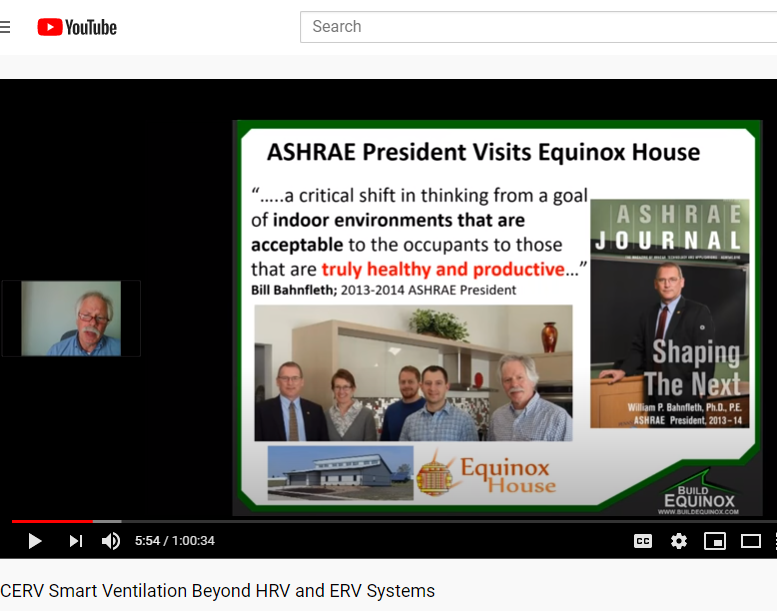 Figure 3: William and Mary Bahnfleth visit Equinox House.
Figure 3: William and Mary Bahnfleth visit Equinox House.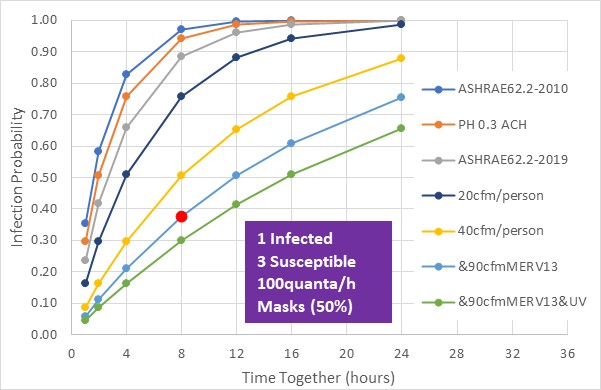 Figure 4: Adding a mask to reduce speech, respiration, cough and sneeze generated infectious particles by 50% in a work environment further reduces disease spread probability by 60% for an 8 hour day in a work environment with 1 infectious and 3 susceptible occupants.
Figure 4: Adding a mask to reduce speech, respiration, cough and sneeze generated infectious particles by 50% in a work environment further reduces disease spread probability by 60% for an 8 hour day in a work environment with 1 infectious and 3 susceptible occupants.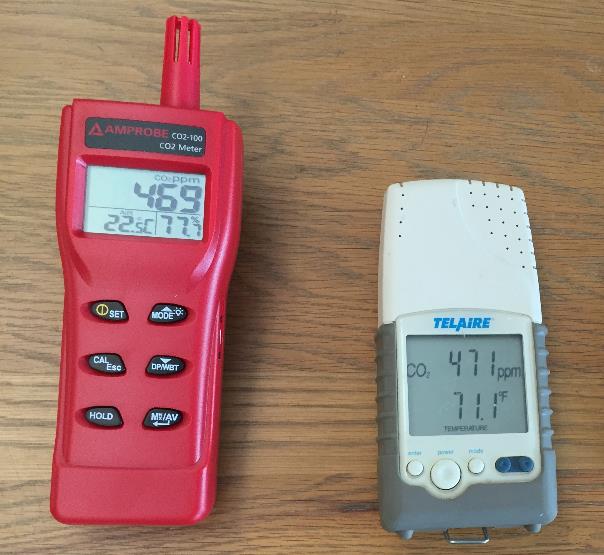 Figure 5: Two handheld carbon dioxide sensing units. The red one costs $260 and the white one (10 years old) was $500.
Figure 5: Two handheld carbon dioxide sensing units. The red one costs $260 and the white one (10 years old) was $500.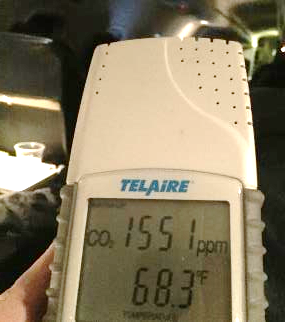 Figure 6: Photo of CO2 sensor reading on a flight from Philadelphia to Burlington Vermont. Very poor fresh air flow. How many others came down with “airline flu”?
Figure 6: Photo of CO2 sensor reading on a flight from Philadelphia to Burlington Vermont. Very poor fresh air flow. How many others came down with “airline flu”?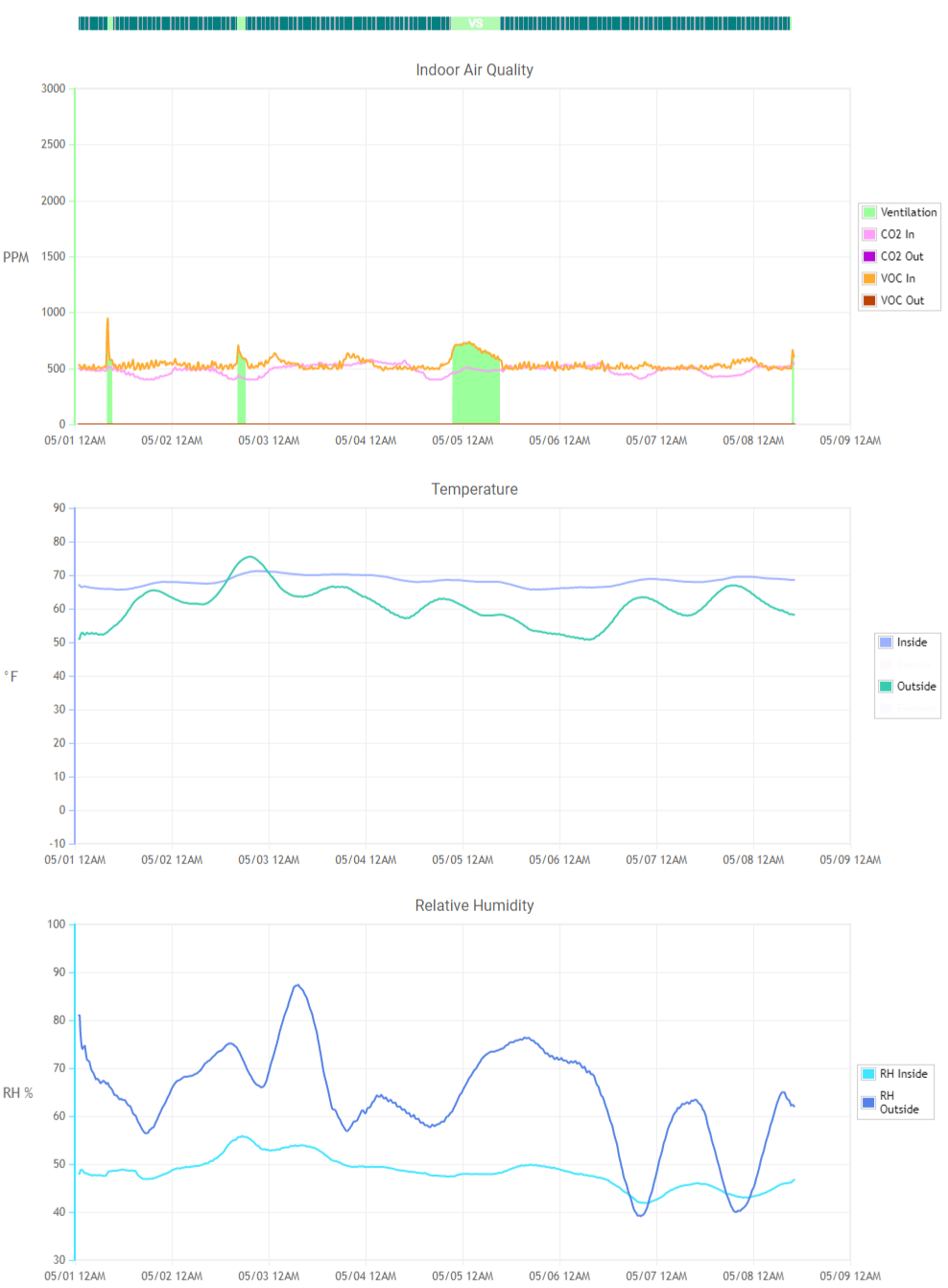 Figure 7: Equinox House (Urbana IL) air quality (CO2 and total VOCs), temperature and humidity during the 1st week of May, 2020. IAQ setpoint was reduced to 650ppm at the beginning of March as Covid-19 transmission accelerated in the US. Comfort and efficiency are not sacrificed for air quality with smart ventilation.
Figure 7: Equinox House (Urbana IL) air quality (CO2 and total VOCs), temperature and humidity during the 1st week of May, 2020. IAQ setpoint was reduced to 650ppm at the beginning of March as Covid-19 transmission accelerated in the US. Comfort and efficiency are not sacrificed for air quality with smart ventilation.

















